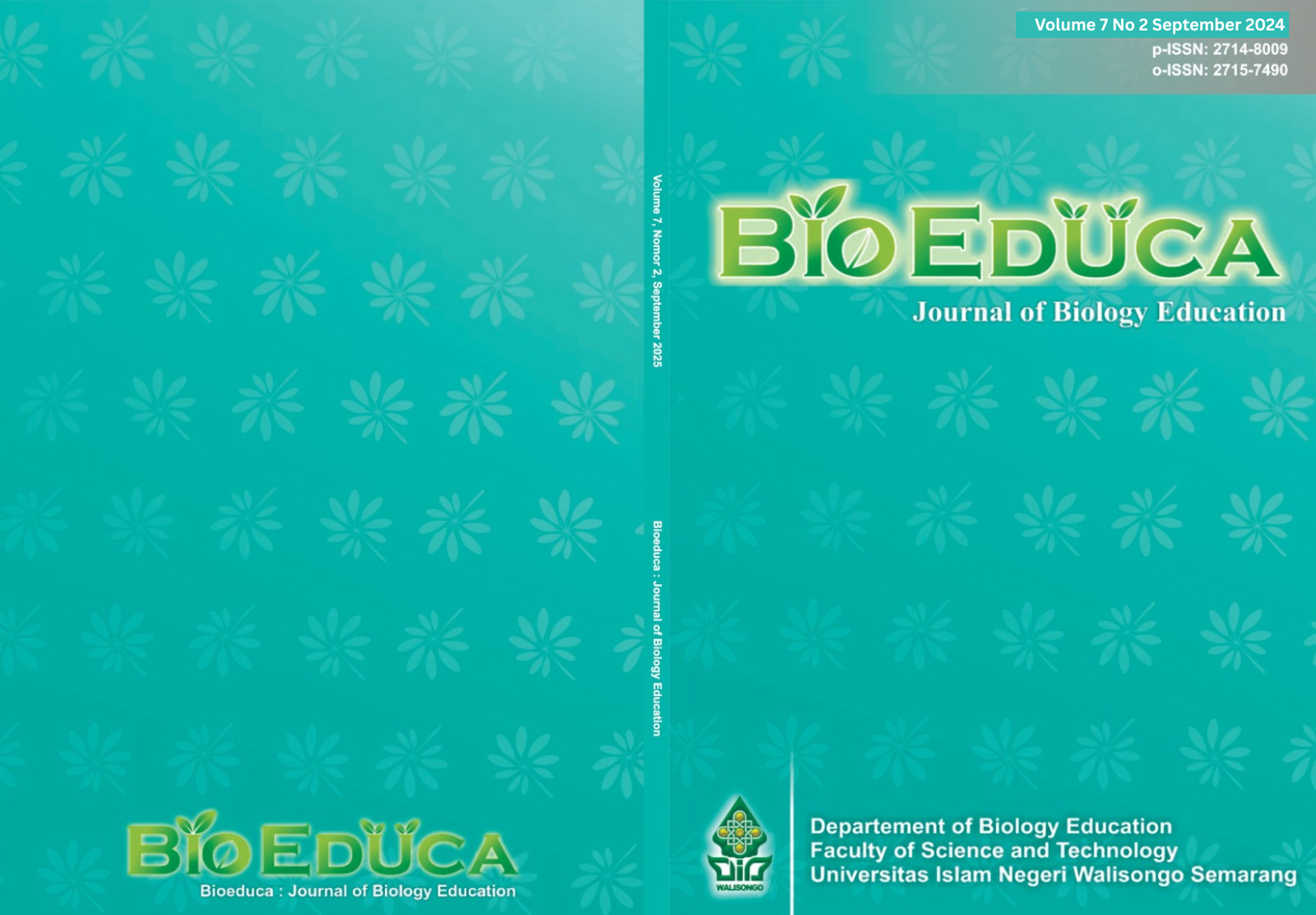Mapping the Potential of Field Laboratories on Mount Galunggung for Learning the Concept of Plantae Biology
Main Article Content
Abstract
Biology education emphasizes the importance of teacher facilitation both inside and outside the classroom. Field laboratory experiences are crucial for deepening conceptual understanding and complementing classroom learning. This research aims to describe the types of mosses and ferns in the Gunung Galunggung area and to map its potential as a field laboratory. The research method used is an exploratory survey through direct observation, interviews, literature studies, field observations, and documentation studies. Data analysis was conducted qualitatively and descriptively using the Milles and Hubberman approach, classifying Gunung Galunggung into 3 stations with 9 zones. The research results show that Gunung Galunggung has 10 genera of mosses from 8 families and 16 genera of ferns from 13 families, indicating significant potential as a field laboratory. This study is expected to serve as a reference for educators and biology students for independent practicum activities in the Gunung Galunggung area.
Downloads
Article Details

This work is licensed under a Creative Commons Attribution-ShareAlike 4.0 International License.
The copyright of the received article shall be assigned to the journal as the publisher of the journal. The intended copyright includes the right to publish the article in various forms (including reprints). The journal maintains the publishing rights to the published articles. Authors are allowed to use their articles for any legal purposes deemed necessary without written permission from the journal with an acknowledgment of initial publication to this journal.

This work is licensed under a Creative Commons Attribution-ShareAlike 4.0 International License.
References
Ade Sarah. (2023). Studi Analisis Pola Pengelompokkan Tumbuhan Paku Sejati (Polypodiopsida) Dari Kawasan Gunung Galunggung Berdasarkan Data Fenetik Dan Filogenetik Secara In Silico . Universitas Siliwangi.
Andrini, V. S. (2017). The effectiveness of inquiry learning method to enhance students’ learning outcome: a theoretical and empirical review. Journal of Education and Practice, 7(3), 38–42.
Emda, A. (2017). Laboratorium Sebagai Sarana Pembelajaran Kimia Dalam Meningkatkan Pengetahuan Dan Ketrampilan Kerja Ilmiah. Lantanida Journal, 5(1). https://doi.org/10.22373/lj.v5i1.2061
Nia Kurnia. (2023). Studi Morfologi Dan Hubungan Kekerabatan Familia Polypodiaceae Di Kawasan Gunung Galunggung Tasikmalaya Sebagai Sumber Belajar Biologi [Universitas Siliwangi]. Http://Repositori.Unsil.Ac.Id/Id/Eprint/8583
Puspitasari, N., Muntini, M. S., Faridawati, F., & ... (2017). Pemanfaatan Laboratorium Alam Sebagai Sarana Belajar Siswa pada Mata Pelajaran IPA Sekolah Dasar. … Nasional MIPA 2016, November.
Putra, R. R., Hernawati, D., & Fitriani, R. (2019). Identifikasi Tumbuhan Lumut di Kawasan Wisata Gunung Galunggung Kabupaten Tasikmalaya Jawa Barat (Vol. 21, Issue 2).
Sadia, I. W. (2014). Model-model pembelajaran konstruktivistik. Graha Ilmu.
Siahaan, I. H. S. (2022). Diversitas Dan Pola Pesebaran Tumbuhan Lumut (Bryophyta) Di Kawasan Hutan Gunung Galunggung Sebagai Sumber Belajar Biologi. Universitas Siliwangi.
Sugiharyanto. (2007). Kelayakan Wilayah Perbukitan Jiwo Sebagai Laboratorium Alam Untuk Praktik Kerja Lapangan Geografi Fisik Mahasiswa Jurusan Pendidikan Geografi. Geomedia, 5(1).
Syafiuddin, M. (2022). Potensi Laboratorium Alam Samarinda Sebagai Sumber Belajar Mata Pelajaran Ips Madrasah Tsanawiyah. Journal Educandum, 8, 1–11.
Yewang, M. (2017). The effect of guided inquiry vs free inquiry instruction method and learning motivation on student learning outcomes. IOSR Journal of Research and Method in Education (IOSR-JRME), 7(5), 36–43.

